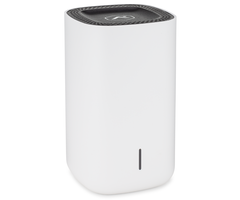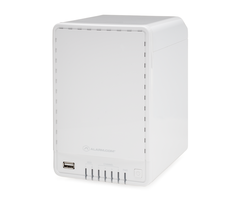How Does an Alarm.com SVR Work?
An Alarm.com SVR works by storing the footage of Alarm.com Cameras and uploading the footage to Alarm.com (ADC). A Stream Video Recorder (SVR) is required if you want to set up a recording schedule or 24-hour continuous recording for your Alarm.com Cameras. There are two (2) ADC SVR models.

You do not need an Alarm.com Stream Video Recorder to use Alarm.com Cameras. But without an SVR, you cannot create a fixed recording schedule for your ADC Cameras. Instead, the cameras will only initiate recordings based on motion, audio, or notification triggers created on Alarm.com. As a result, an SVR module is the only way to establish 24-hour continuous recording for your ADC Cameras. It is also the only way to view camera footage locally without accessing your ADC account.
When an Alarm.com Camera records footage, it sends the footage to the the ADC Servers and the Stream Video Recorder. You can view both the ADC Cloud footage and the SVR footage by accessing your ADC account, either through the website or the mobile app. Any footage saved on the SVR will be accessible from your ADC account, as long as the SVR has an active internet connection. More information on accessing footage stored on the SVR remotely can be found in this helpful FAQ.
There are a few advantages to using an SVR with your Alarm.com Cameras. First is how the SVR is needed to set up a recording schedule for your Alarm.com Cameras. The other benefit is that the SVR can be used to save camera footage during internet outages. As long as your internet router remains powered on, footage will still be passed from your ADC Cameras to the SVR. This is true even if an active internet connection is not maintained. Once the internet is restored, the SVR will automatically send the saved video clips to the Alarm.com Cloud for remote viewing. For that reason, you might consider providing a backup power source for your internet router and the SVR itself. This FAQ explains more information on how the SVR behaves when the internet goes out.
There are two (2) Alarm.com SVR modules available. These are the ADC-SVR100 and the ADC-SVR122. The ADC-SVR100 has since been discontinued by Alarm.com, but the ADC-SVR122 is still available for purchase. The ADC-SVR100 has the larger hard drive option, as you can configure the device to store up to 4TB (two slots, with up to 2TB each). The newer ADC-SVR122 only has one slot that can be used with a maximum hard drive size of 2TB. Both devices allow users to swap out the hard drive(s) to save more footage. However, the ADC-SVR122 can support up to eight (8) ADC Cameras, while the ADC-SVR100 can only support a maximum of four (4). Additionally, only the ADC-SVR122 has an HDMI port for viewing saved footage locally.
Please note that if the SVR hard drive runs out of space, the oldest footage will be deleted to make more space. This automatic deletion process is conducted in entire days of storage at a time. Deleted footage cannot be recovered. Users should make sure to save their clips before this happens. Alarm.com does not provide notification for low storage space, so you will need to regularly check your available storage space to make sure you aren't running low.
An Alarm.com SVR module must be set up through the Alarm.com website. As a result, you cannot use an ADC SVR and ADC Cameras without active Alarm.com service. Alarm Grid customers will need a monitoring plan that includes video surveillance. Compatible plans include the Platinum Plan, Self-Platinum Plan, and the Video-Only Plan. More information is available on this page, which explains why ADC service is needed to use ADC Cameras.
Did you find this answer useful?
We offer alarm monitoring as low as $10 / month
Click Here to Learn MoreRelated Products


Related Categories
- Answered
